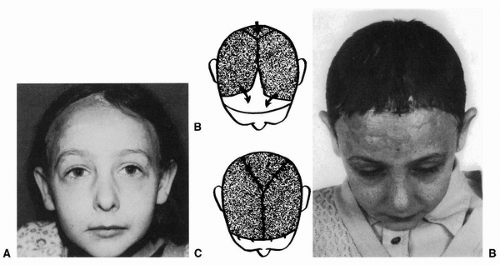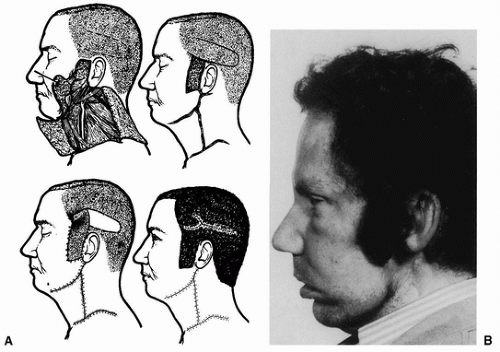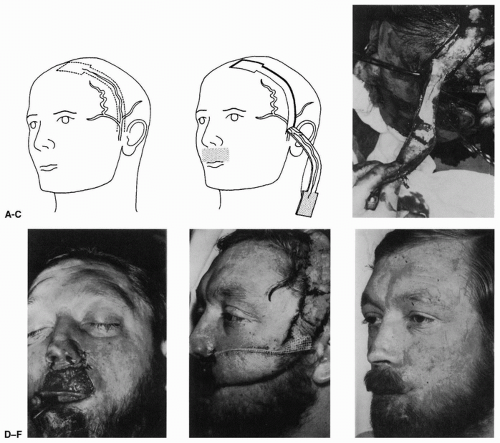Hair-Bearing Skin Flaps
J. S. P. WILSON
M. D. BROUGH
Hair-bearing skin flaps of the scalp can be used for reconstruction of hair-bearing areas of the scalp itself and also of sideburns and the moustache and beard areas in men. Bald areas of the scalp may be used to reconstruct non-hair-bearing areas of the face or oral cavity. Immediate skin cover to large defects of the cranium may be provided by large, narrow-based flaps or single or multiple, broad-based flaps.
Scalp flaps used to reconstruct defects of the scalp may be axial pattern or random pattern, but those used in reconstructing other areas are almost invariably axial-pattern flaps and most commonly are based on the posterior branch of the superficial temporal artery and its associated veins. Much of this chapter is devoted to flaps based on this vessel, as they are the most versatile and most useful flaps of the hair-bearing scalp.
Hair-Bearing Margin of the Forehead
Defects of this margin, other than the receding hairline of male pattern baldness, are not common but, when present, cause a significant deformity. They usually can be reconstructed with transposition flaps based on the posterior branch of the superficial temporal artery. A secondary defect may leave an obvious bald patch at the back of the scalp. If the flap is large and the galea is cross-hatched with multiple incisions, it will expand and a secondary defect may be avoided. Figure 165.1 shows how three flaps were expanded in a girl aged 8 years to reconstruct the anterior hairline, which had been destroyed by a burn injury in infancy.
Eyebrows
Eyebrows help frame the forehead and divide the upper third from the middle third of the face. When thick, as commonly found in men, they can be reconstructed readily on narrow- pedicled flaps based on the posterior branch of the superficial temporal artery. The reconstruction of a hairy eyebrow, because it is the narrowest area of hair-bearing skin, provides an excellent model to explore the potential of the narrow-pedicled hair-bearing flaps; however, it is not always possible to give adequate cover to the vascular pedicle in the grafted forehead of the burned patient.
A narrow-pedicled, hair-bearing flap may be used as an alternative. As long as the pedicle includes the posterior superficial temporal vessels, the hair-bearing flap can be angled to improve the direction of the hair. Bilateral hair-bearing flaps were used in a patient with burn scarring of the forehead (Fig. 165.2).
It may well be, however, that one of the posterior superficial temporal vessels has been divided or used previously for the construction of a forehead. It is then necessary to raise a flap with an even longer pedicle to allow bilateral reconstruction of the eyebrow. Such a case is illustrated in Figure 165.3A. The contralateral eyebrow could be shaped primarily, however. The ipsilateral eyebrow was too large and
had to be revised subsequently (Fig. 165.3B). Still, this exercise does indicate the potential of narrow-pedicled flaps.
had to be revised subsequently (Fig. 165.3B). Still, this exercise does indicate the potential of narrow-pedicled flaps.
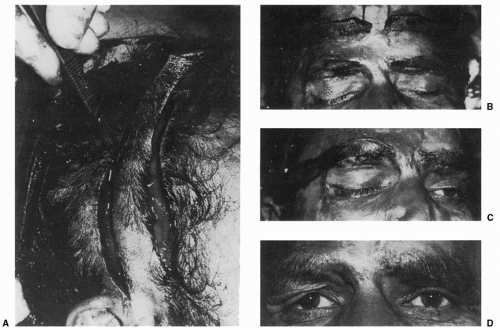 FIGURE 165.2 A: Narrow-pedicle flap being raised to reconstruct the right eyebrow. B-D: Composite picture of bilateral reconstruction of eyebrows as narrow-pedicle flaps. |
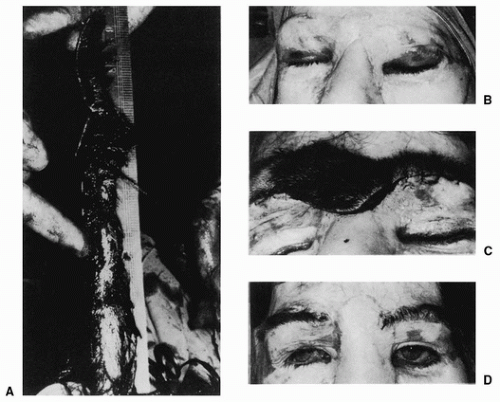 FIGURE 165.3 A: Extended narrow-pedicle flap for the bilateral reconstruction of the eyebrows. B-D: Composite photograph showing bilateral reconstruction of the eyebrows with a single pedicle. |
Frontal Temporal Hairlines and Sideburn
Two cosmetic units can be reconstructed by a superiorly based transposition flap of postauricular scalp. The position of the normal hairline and sideburn is delineated (Fig. 165.4A), and the scar tissue is excised. A bipolar flap is raised (Fig. 165.4B). The anterior flap completes the frontal hairline. The large posterior flap provides hair-bearing skin to create the lateral temporal hairline and sideburn (Fig. 165.4C).
Sideburns
Sideburns, particularly in men, are important in framing the face. They may be reconstructed by a flap based on the posterior branch of the superficial temporal artery, but this flap needs to be rotated through almost 180 degrees at its base. Sometimes the pathology causing loss of the sideburn or its treatment also has caused loss of the posterior branch of the superficial temporal artery. This may occur, for example, following radical parotid surgery. If this has occurred, a transverse local transposition flap from the scalp based anteriorly, as illustrated in Figure 165.5, may be used for reconstruction.
Moustache
Large areas of full-thickness skin losses in the upper lips of men are readily reconstructed with a scalp flap based on the posterior branch of the superficial temporal artery. Many different shapes of moustache can be fashioned (6), but the standard reconstruction is shown in Fig. 165.6. The reconstruction should be symmetrical, so the defect may have to be enlarged to the size of the cosmetic unit. The scars introduced by the flap are well concealed by the hair of the flap. The reconstruction of a philtrum by introduction of an Abbé flap from the lower lip will improve the appearance.
Full-thickness reconstruction of the upper lip can be achieved using a bipolar flap with a hair-bearing flap based on the posterior branch of the superficial temporal artery providing skin cover; a hairless forehead flap based on the anterior branch of the superficial temporal artery provides buccal cavity lining. When this reconstruction is executed, it is usually necessary to add a tongue flap to reconstruct the vermilion border. This not only prevents hairs turning into the oral cavity, causing irritation, but also improves the contour of the lip.
Beard
Reconstruction of areas of skin loss in the bearded patient should be repaired with hair-bearing skin. This is well illustrated in a patient with severe acne keloid (Fig. 165.7A). Free skin grafts had been unsatisfactory. The creation of a hemi-beard restored the cosmetic appearance with no recurrence of the keloid (Fig. 165.7B-D).
A total beard area may be required, and it is important to note the position of the crown on the scalp and to take scalp
tissue in front of this for the reconstruction whenever possible. Transfer of the scalp from the crown is safe, but it can produce a bizarre appearance owing to the centrifugal direction of hair growth at this point.
tissue in front of this for the reconstruction whenever possible. Transfer of the scalp from the crown is safe, but it can produce a bizarre appearance owing to the centrifugal direction of hair growth at this point.
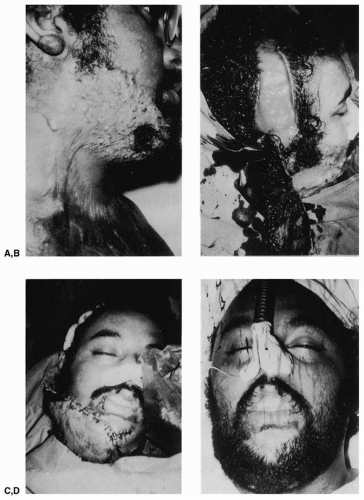 FIGURE 165.7 A: Massive acne keloid of right bearded area. B: Raising of narrow-pedicle scalp flap. C: Scalp flap inset. D: Final result showing reconstruction of the beard and absence of keloid. |
The lower lip, following full-thickness loss, can be reconstructed like the upper lip. Again, a tongue flap should be introduced to provide a vermilion border. It is also possible to reconstruct both the moustache and beard areas with one flap (Fig. 165.8). When this is done, a central incision is made in the flap, taking care to avoid dividing any major vessels, to provide an oral stoma. A tongue flap is introduced to provide a vermilion border to the lower lip and to the upper lip, if necessary. Local transposition flaps may have to be introduced into the commissures to increase mobility between the lips.
Stay updated, free articles. Join our Telegram channel

Full access? Get Clinical Tree


